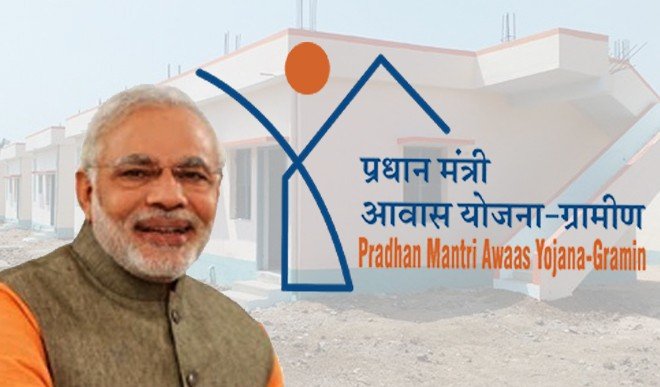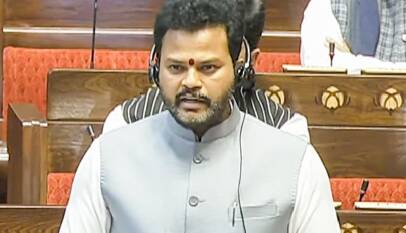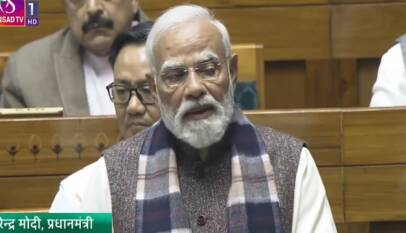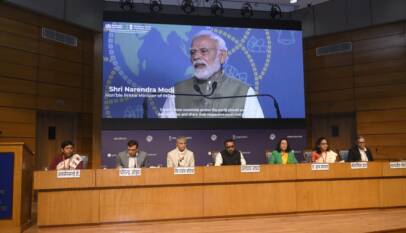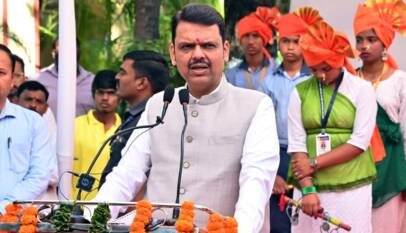Pradhan Mantri Awas Yojana- Rural
Building a Better Future for Rural India
In May 2014, Prime Minister Narendra Modi’s vision and the government’s steadfast commitment to building and providing pucca houses for poor people in rural and urban areas culminated in the launch of Pradhan Mantri Awas Yojana—Urban (2015) and Gramin (2016).
Pradhan Mantri Awas Yojana – Rural
The Pradhan Mantri Awas Yojana – Rural (PMAY – Rural) was launched on 20th November 2016, aiming to provide housing for the poorest segments of society. Beneficiaries are selected through a rigorous three-stage validation process that includes the Socio-Economic Caste Census (SECC 2011) and Awaas+ (2018) surveys, Gram Sabha approvals, and geo-tagging. This ensures that aid reaches the most deserving individuals. The scheme has further incorporated IT and Direct Benefit Transfer (DBT) for efficient fund disbursement. It has also implemented region-specific housing designs, and evidence-based monitoring through geo-tagged photos at various construction stages.
Originally targeting 2.95 crore houses to be completed by 2023-24, the scheme got extended with 2 crore more houses, with a total outlay of ₹3,06,137 crore for FY 2024-29 and ₹54,500 crore allocated for FY 2024-25.
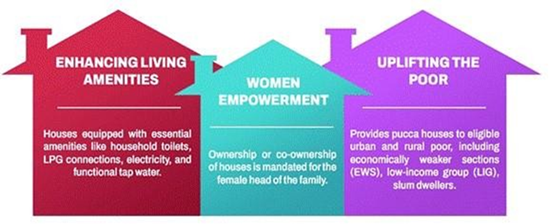
On August 9, 2024, the Union Cabinet, chaired by Prime Minister Shri Narendra Modi, approved the proposal for financial assistance to be provided for the construction of two crore more houses at the existing unit assistance of Rs.1.20 lakh in plain areas and Rs.1.30 lakh in North Eastern Region States and Hill States of Himachal Pradesh, Uttarakhand, Union Territories of Jammu & Kashmir, and Ladakh.
Application Process
To avail benefits under PMAY-G, beneficiaries must go through a simple online registration process: https://web.umang.gov.in/landing/department/pmayg.html
Progress under PMAY-G:
Under the Pradhan Mantri Awas Yojana – Gramin (PMAY-G), the Government has set an ambitious target to build 3.32 crore houses. As of November 19, 2024, 3.21 crore houses have been sanctioned, and 2.67 crore houses have been completed, significantly improving the living conditions of millions of rural families.

The scheme has also placed a special focus on women empowerment, with 74% of sanctioned houses owned by women solely or jointly. The scheme now aspires to provide 100% ownership to women. Skilled employment has also been a priority, with almost 3 lakh rural masons trained in disaster-resilient construction, boosting their employability.
The construction of houses for two crores more households is expected to benefit nearly ten crore individuals. The approval would facilitate the building of safe and secure houses of good quality with all the basic amenities for all people without housing and people living in dilapidated and kutcha houses. This will ensure the safety, hygiene and social inclusiveness of the beneficiaries.
Key Features of PMAY-G are:
- A minimum unit (house) size of 25 sq. mt., including a dedicated area for hygienic cooking.
- The beneficiaries construct quality houses using local materials and trained masons.
- The beneficiary also has a wide selection of structurally sound, aesthetically, culturally, and environmentally appropriate house designs available rather than standard cement concrete house designs.
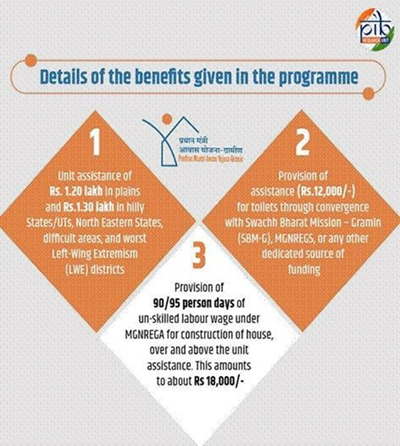
- Institutional Loan for Construction
- Loan up to ₹70,000 is available to eligible beneficiaries at a 3% reduced interest rate for the construction of their permanent house.
- The maximum principal amount for which subsidy can be availed is ₹2,00,000, ensuring that the construction cost is covered comprehensively.
- This additional loan support helps ease the financial burden on beneficiaries, making home construction affordable for rural households.
- Convergence with Government Schemes for Enhanced Benefits
PMAY-G works in conjunction with various other government initiatives to ensure comprehensive support for rural households. These schemes aim to improve the quality of life by addressing multiple needs such as sanitation, employment, cooking fuel, and water supply.
- Swachh Bharat Mission-Gramin (SBM-G): Beneficiaries receive up to ₹12,000 to construct toilets, ensuring better sanitation facilities in rural homes.
- MGNREGA (Mahatma Gandhi National Rural Employment Guarantee Act): Eligible households can avail 95 days of employment as unskilled labour, specifically under Rural Mason Training, with a daily wage of ₹90.95.
- Pradhan Mantri Ujjwala Yojana (PMUY): Under this scheme, each house is entitled to a free LPG connection, promoting cleaner and safer cooking fuel.
- Piped Drinking Water & Electricity Connections: Beneficiaries are provided with access to piped drinking water and electricity connections, improving their living standards and reducing the health risks associated with unsafe water and irregular power supplies.
- Social & Liquid Waste Management: PMAY-G also converges with government programs for managing waste, ensuring better health and hygiene for the beneficiaries.
- Payment Transfer Process
To ensure transparency and efficiency, all payments under PMAY-G are made electronically. Payments are directly transferred to the beneficiaries’ bank accounts or post office accounts that are linked to Aadhaar, ensuring that funds reach the intended recipients without delays.
Technological innovation plays a pivotal role here. The Awaas+ 2024 mobile app ensures transparent beneficiary identification with Aadhaar-based face authentication and 3D house designs in collaboration with the Central Building Research Institute (CBRI), enabling beneficiaries to choose suitable designs.
- Eligibility Criteria for Beneficiaries
The beneficiaries of PMAY-G are identified using specific criteria, ensuring that the most deserving households, especially those facing housing deprivation, are prioritized. 4. Under this scheme, the beneficiaries are identified through SECC 2011 and Awaas+ (2018) surveys, verified by Gram Sabhas. Over the last decade, the permanent waiting list of SECC 2011 has been saturated, and more than 20 states’ Awaas+ 2018 lists are also completed.
The eligibility criteria are as follows:
- Houseless Households: All households without any shelter.
- Households with Kuccha Houses: Households living in homes with kuccha walls and kuccha roofs or houses with zero, one, or two rooms as per the Socio Economic and Caste Census (SECC) 2011.
Compulsory Inclusion Criteria:
The following categories of people are automatically included in the list of beneficiaries:
- Destitute households or those living on alms.
- Manual scavengers
- Primitive Tribal Groups.
- Legally released bonded laborers.
Priority for Assistance
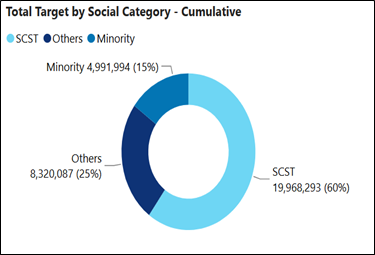
| *As on November 19, 2024 |
Within the universe of eligible beneficiaries, priority will be given to the following categories:
- Houseless households.
- Households with zero or fewer rooms (in the case of households with more than one room, priority will be given to those with fewer rooms).
Special prioritization will also be given based on cumulative deprivation scores, calculated using the following socio-economic parameters:
- Households with no adult member aged 16 to 59.
- Female-headed households with no adult male member.
- Households with no literate adult above 25 years.
- Households with a disabled member and no able-bodied adult.
- Landless households dependent on manual casual labor.
Earmarking of Targets
PMAY-G also ensures targeted assistance for specific disadvantaged groups:
- Scheduled Castes (SC) and Scheduled Tribes (ST): The scheme reserves minimum 60% of targets for SC/ST households, with 59.58 lakh SC houses and 58.57 lakh ST houses completed.
- Another crucial initiative for fulfilling the objective of “Housing for All” is the Dharati Aaba Tribal Village Utkarsh Abhiyan which focuses on tribal development, covering 63,843 villages, benefiting over 5 crore tribal people across 30 States/UTs. This initiative addresses housing and critical gaps in social infrastructure, health, education, and livelihoods, with 72.31 lakh tribal families already benefitting.
- 5% of the target is reserved for differently-abled beneficiaries, and another 5% prioritizes housing for families affected by natural disasters, such as the Fani Cyclone in Odisha
- Minorities: 15% of the total funds at the national level are earmarked for Minority households. The allocation of targets among States/UTs is based on the proportionate rural population of minorities according to the Census 2011 data.
- Exclusion Criteria
Certain households are excluded from the scheme based on their financial status and assets. The following households will be automatically excluded:
- Households with a Kisan Credit Card having a credit limit of ₹50,000 or above.
- Government employees or those with non-agricultural enterprises.
- Households with monthly income over ₹15,000 or those paying income tax.
- Households owning assets such as refrigerators, landline phones, or irrigated land (more than 2.5 acres).
To enhance inclusivity, the exclusion criteria have been reduced from 13 to 10, conditions such as ownership of a fishing boat or motorized two-wheeler have been removed, and the income threshold has been raised to ₹15,000 per month.
CONCLUSION
The Pradhan Mantri Awas Yojana – Gramin (PMAY-G) has made remarkable progress in transforming the living conditions of millions of rural families by providing safe and secure housing. PMAY-G is more than a housing scheme—it is a movement to empower rural India, ensure social equity, and uplift marginalized communities. With the recent approval for constructing two crore additional houses, the Government continues to reinforce its commitment to achieving “Housing for All,” ensuring that every eligible household has access to quality housing and a dignified life.
Sant Jagnade Maharaj Took the Thoughts of Sant Tukaram Maharaj to the Masses – Chief Minister Devendra Fadnavis
Renaming of Government Industrial Training Institute Nagpur, Dec 2025 : Some orthodox peop…

